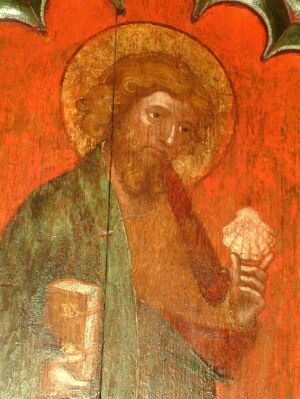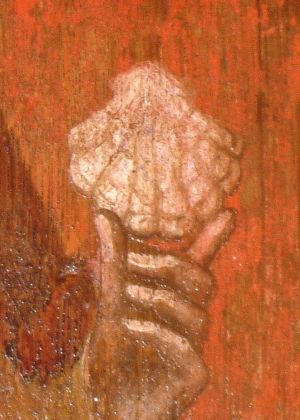|
The church of All Saints, Clifton in Bedfordshire is fortunate to have a rare survival in the form of painted panels from a late fourteenth century rood-screen. Most medieval parish churches once had such a screen; made of wood or stone they were designed to separate the chancel from the nave. In 1972, panels from such a screen, which had hung on the walls of the church tower at Clifton for over 100 years, were carefully erected as an impressive tower arch screen forming an entrance to the choir vestry. They were of fine oak and, underneath much overpainting, a painted figure could be faintly discerned on each panel. Between 1988 and 1992 the panels were painstakingly cleaned and preserved in situ by a small team of expert conservators. The sixteen panels depicting nine saints, each with traditional symbols to denote who they are, and seven prophets, are now believed to be some of the earliest paintings on an English rood-screen. One of the panels shows St James, “the Great” (see images). He holds a scallop shell, the Compostela pilgrim badge which became firmly associated with James from the 12th century onwards through the pilgrimages to his shrine at Santiago de Compostela. A detailed account of the scallop as a symbol of this saint can be found in Ian Cox’s familiar book ”The Scallop, Studies of a shell and its influences on humakind” which was produced by the Shell Oil Company in 1957. The origins of the scallop symbol have become somewhat obscured with time and even the medieval stories seem to have been invented as ways of justifying an existing custom such as “…the story of a horseman, saved from drowning by St James, who found on emerging from the waves that both he and his horse were covered with scallops.” Nevertheless the scallop came to symbolize the journey of both the pilgrim and originally, as the legend has it, St James, from the sea inland to Santiago de Compostela. As a very early example of an advertising symbol at a time when few could read or write, the scallop badge was an idea of genius. The scallop of which pilgrim’s would have attached a valve to their coat or hat to honour St James was probably more commonly the Atlantic Pecten maximus (L.) than the so-called “Pilgrim’s Scallop”, P.jacobaeus (L.), a mainly Meditteranean species. However both were, and still are, fished for food and valves would have been available for use. The depiction of St James with the scallop held aloft in the fingertips of his left hand in the image on the Clifton rood-screen panel, was an invitation to the people of the village to visit his grave, an invitation to go on pilgrimage. |
Fig 1 Rood-screen panels from the All Saints Church, Clifton. (Photo Peter Topley)
Fig 2 Rood-screen panels from the All Saints Church, Clifton. (Photo Peter Topley) |
A Mediaeval Scallop Shell
Issue
10
Page
19


